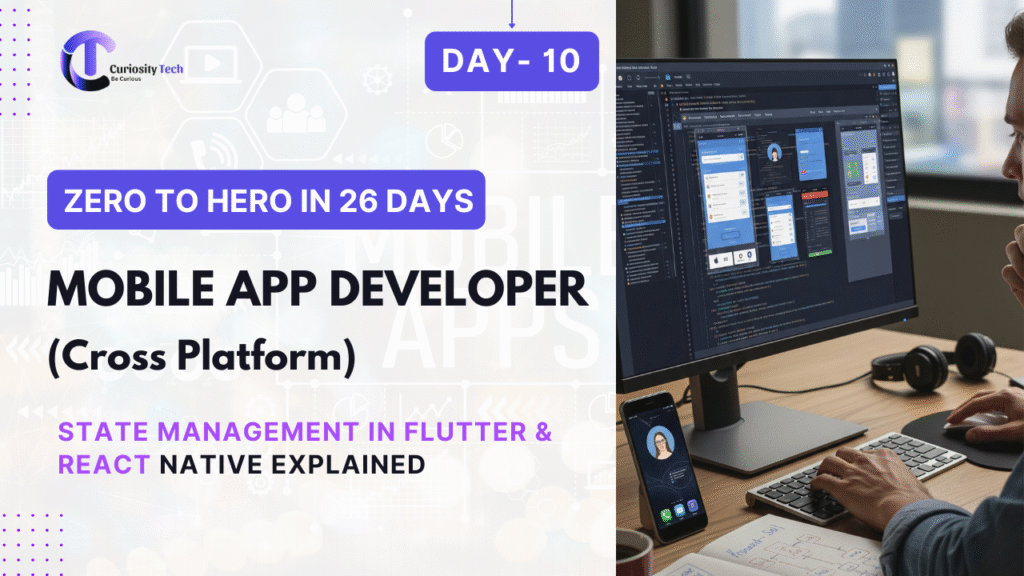Introduction
The mobile app ecosystem is evolving at an unprecedented pace. Cross-platform development frameworks like Flutter and React Native have revolutionized app creation, but 2025 is shaping up to be a year of new innovations and best practices.
This blog explores the emerging trends, tools, and methodologies that will define cross-platform mobile development in 2025, helping developers stay ahead of the curve and deliver high-performance, user-friendly, and future-proof applications.
1. AI-Powered Development
Artificial Intelligence is transforming app logic, UI design, testing, and optimization:
- AI-assisted coding: Tools like GitHub Copilot and OpenAI Codex help generate boilerplate code, automate repetitive tasks, and suggest best practices.
- Intelligent UI/UX: AI can adapt UI layouts based on user behavior, improving engagement.
- Predictive analytics: Apps can anticipate user needs, delivering personalized experiences.
Example: A task management app can automatically reorder tasks based on predicted priorities using AI models.
2. Enhanced Low-Code & No-Code Integration
Cross-platform frameworks are integrating with low-code/no-code tools:
- Tools like FlutterFlow allow developers to rapidly prototype apps while keeping the code exportable for custom logic.
- Companies adopt citizen development strategies to empower non-technical staff to contribute to app creation.
Impact: Faster MVP launches, reduced development costs, and collaboration between business and technical teams.
3. Web3 and Blockchain Integration
Blockchain is increasingly influencing mobile apps:
- Decentralized apps (dApps): Cross-platform frameworks now support integration with Ethereum, Solana, and other chains.
- NFT and token-based features: Apps can include digital collectibles, rewards, and in-app marketplaces.
- Secure authentication: Blockchain-based identity verification is gaining traction.
Example: A React Native app integrating NFT rewards for user achievements.
4. Advanced Animations and Micro-Interactions
2025 will see micro-interactions becoming a core differentiator:
- Motion design will not just enhance aesthetics but guide user behavior.
- Flutter and React Native libraries are supporting more complex gesture-based animations, transitions, and Lottie-based interactive visuals.
Trend: Apps will feel more native than ever, with smooth, context-aware motion.
5. Cross-Platform Augmented Reality (AR) & Virtual Reality (VR)
- AR/VR integration is becoming feasible in cross-platform apps thanks to frameworks like Unity, ARCore, and ARKit, and Flutter plugins for AR.
- Use Cases: Retail apps with virtual try-ons, educational apps with immersive simulations, and interactive games.
Example: A Flutter app using ARKit to preview furniture in a user’s home environment.
6. Performance-First Frameworks
2025 emphasizes ultra-fast, lightweight apps:
- Flutter 4.x and React Native 1.0+ are improving runtime performance, reducing memory usage, and supporting incremental compilation.
- Developers are focusing on app startup time, memory optimization, and low-latency animations.
Pro Tip: Regular profiling and optimization using DevTools or performance monitors is essential to stay ahead.
7. Increased Focus on Security & Privacy
With stricter regulations like GDPR, CCPA, and emerging data privacy laws, security is central:
- End-to-end encryption is standard for sensitive apps.
- On-device AI processing reduces data sent to servers, enhancing privacy.
- Secure authentication using biometric and blockchain-based solutions will grow.
8. Cloud-Native Mobile Apps
Integration with cloud services will be deeper:
- Using Firebase, AWS Amplify, or Azure Mobile Apps for backend services, authentication, storage, and real-time updates.
- Apps will leverage serverless architecture for scalability and cost efficiency.
Example: A Flutter chat app using Firebase Cloud Functions for message encryption and push notifications.
How to Become Future-Ready in Cross-Platform Development
- Learn AI-assisted development tools.
- Explore AR/VR, Web3, and blockchain integration.
- Master performance optimization techniques for large-scale apps.
- Stay updated on mobile security, privacy, and compliance.
- Experiment with low-code platforms for prototyping and rapid iteration.
Integrating CuriosityTech
At CuriosityTech (https://curiositytech.in), we stay ahead of trends in cross-platform mobile development. Our team helps businesses implement AI-driven features, AR/VR, blockchain integration, and performance optimization. Contact us at +91-9860555369, email contact@curiositytech.in, or visit 1st Floor, Plot No 81, Wardha Rd, Gajanan Nagar, Nagpur. Follow our insights on Instagram: curiositytechpark, LinkedIn: Curiosity Tech, and Facebook: Curiosity Tech.
Conclusion
The future of cross-platform mobile development is dynamic, intelligent, and immersive. By embracing AI, Web3, advanced motion design, AR/VR, and cloud-native approaches, developers can deliver apps that are fast, secure, and highly engaging. Staying updated with these trends ensures apps remain competitive in 2025 and beyond.



